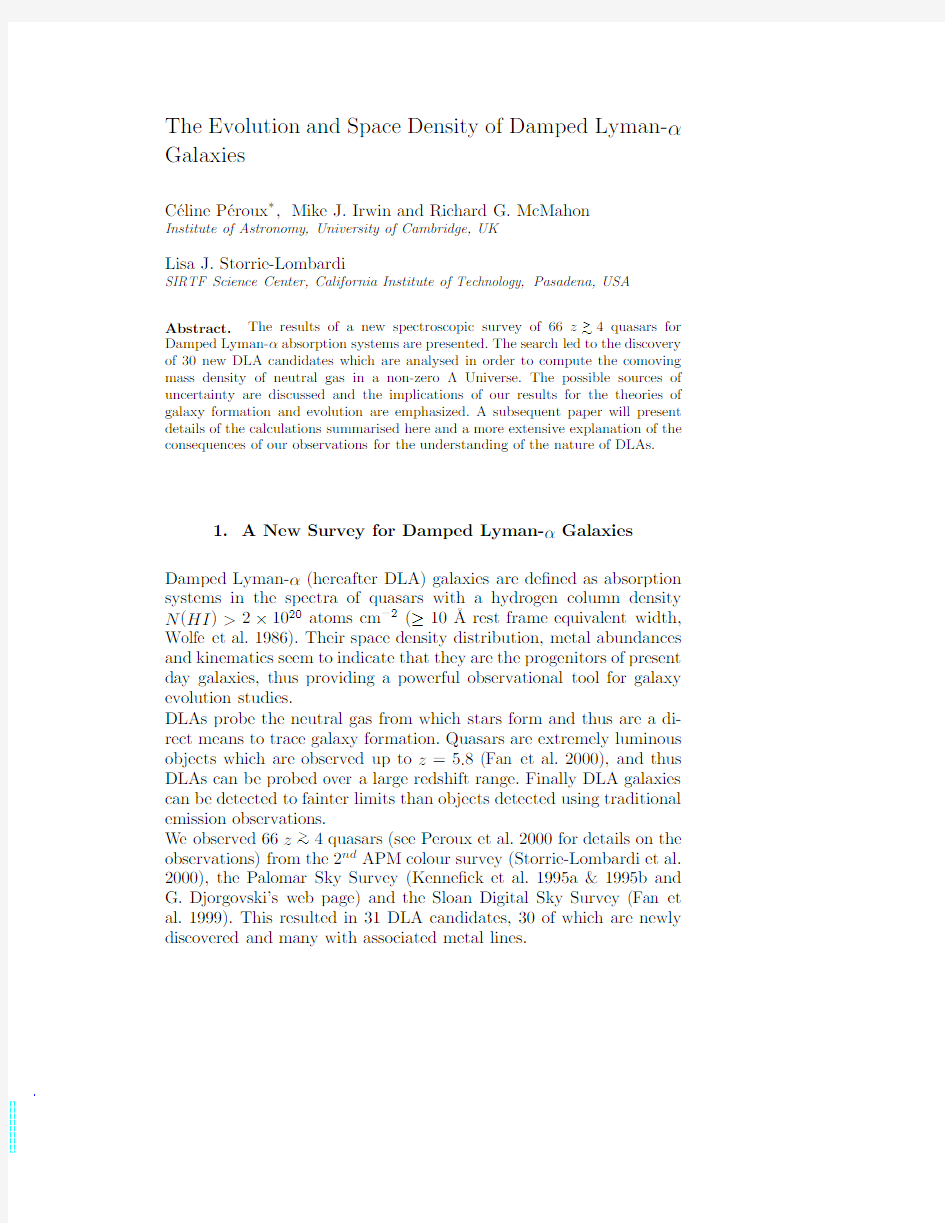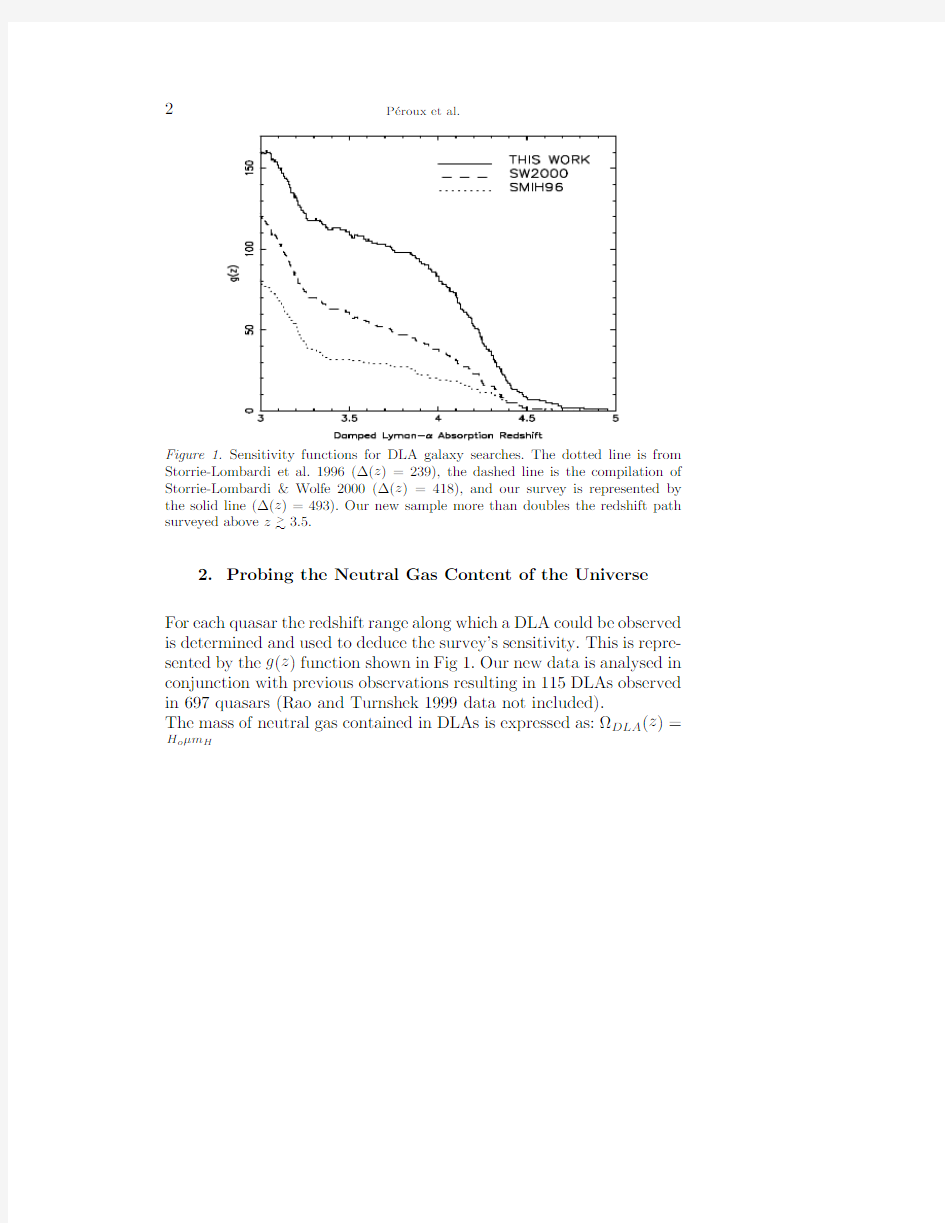

a r
X
i
v
:a
s t
r o
-
p
h
/
8
1
7
2v
1
1
1
A
u
g
2
The Evolution and Space Density of Damped Lyman-αGalaxies C′e line P′e roux ?,Mike J.Irwin and Richard G.McMahon Institute of Astronomy,University of Cambridge,UK Lisa J.Storrie-Lombardi SIRTF Science Center,California Institute of Technology,Pasadena,USA Abstract.The results of a new spectroscopic survey of 66z >~4quasars for Damped Lyman-αabsorption systems are presented.The search led to the discovery of 30new DLA candidates which are analysed in order to compute the comoving mass density of neutral gas in a non-zero ΛUniverse.The possible sources of uncertainty are discussed and the implications of our results for the theories of galaxy formation and evolution are emphasized.A subsequent paper will present details of the calculations summarised here and a more extensive explanation of the consequences of our observations for the understanding of the nature of DLAs.1.A New Survey for Damped Lyman-αGalaxies Damped Lyman-α(hereafter DLA)galaxies are de?ned as absorption systems in the spectra of quasars with a hydrogen column density N (HI )>2×1020atoms cm ?2(≥10?A rest frame equivalent width,Wolfe et al.1986).Their space density distribution,metal abundances and kinematics seem to indicate that they are the progenitors of present day galaxies,thus providing a powerful observational tool for galaxy evolution studies.DLAs probe the neutral gas from which stars form and thus are a di-rect means to trace galaxy formation.Quasars are extremely luminous objects which are observed up to z =5.8(Fan et al.2000),and thus DLAs can be probed over a large redshift range.Finally DLA galaxies
can be detected to fainter limits than objects detected using traditional emission observations.
We observed 66z >~4quasars (see Peroux et al.2000for details on the observations)from the 2nd APM colour survey (Storrie-Lombardi et al.2000),the Palomar Sky Survey (Kenne?ck et al.1995a &1995b and G.Djorgovski’s web page)and the Sloan Digital Sky Survey (Fan et al.1999).This resulted in 31DLA candidates,30of which are newly discovered and many with associated metal lines.
2P′e roux et al.
Figure1.Sensitivity functions for DLA galaxy searches.The dotted line is from Storrie-Lombardi et al.1996(?(z)=239),the dashed line is the compilation of Storrie-Lombardi&Wolfe2000(?(z)=418),and our survey is represented by the solid line(?(z)=493).Our new sample more than doubles the redshift path surveyed above z>~3.5.
2.Probing the Neutral Gas Content of the Universe
For each quasar the redshift range along which a DLA could be observed is determined and used to deduce the survey’s sensitivity.This is repre-sented by the g(z)function shown in Fig1.Our new data is analysed in conjunction with previous observations resulting in115DLAs observed in697quasars(Rao and Turnshek1999data not included).
The mass of neutral gas contained in DLAs is expressed as:?DLA(z)= H oμm H
The Evolution and Space Density of Damped Lyman-αGalaxies3
Figure2.The circles show the neutral gas in Damped Lyman-αgalaxies(the?lled circles are our observations and the open circles are Rao&Turnshek1999results). Vertical bars correspond to1σerrors and the horizontal bars indicate bin sizes.The stars are the total HI including a correction for the neutral gas contained in systems with column densities below2×1020atoms cm?2.The triangle at z=0is from Natarajan&Pettini1997who used a recent galaxy luminosity function to reproduce the local HI mass measured by Rao&Turnshek1993.The squares,?F HP and?GO (Fukugita,Hogan&Peebles1998and Gnedin&Ostriker1992respectively)are ?baryons in local galaxies.The semi-analytical models from Somerville,Primack& Faber2000are overplotted(see text for detailed explanations of the models).
f(N,z)=(f?/N?)(N/N?)?βe?N/N?.Using the parameters determined by Storrie-Lombardi et al.1996,N?=21.63±0.35andβ=1.48±0.30, results in a~20%increase in?for z≤3.5.For z>3.5systems,our observations indicate a steepening of the low column density end of the DLA distribution(where much of the mass resides)in comparison with our previous study and leads to a factor of~2correction(as shown by the stars in Fig2).
3.Discussion
Most of the uncertainties discussed here seem to indicate that?DLA is being underestimated.At low redshift,Rao&Turnshek1999used a
4P′e roux et al.
di?erent method(based on the observations of Lyman-αin identi?ed Mg II systems)and HST data to derive a higher neutral gas content in DLAs(Fig2).These results are surprisingly high and might be due to low number statistics or might indicate that high redshift results are underestimated.More uncertainties arise in the fact that dust is likely to produce observational biases unaccounted for here and that the exact nature of DLAs is unknown.In particular,they might be di?erent types of object at di?erent redshift.Finally,higher resolution data are necessary in order to identify multiple systems.
Several groups(Kau?mann&Haehnelt2000,Somerville,Primack& Faber2000)have included more realistic physics in their simulations to construct semi-analytical models of galaxy formation which,among other things,predict the evolution of cold gas in the Universe.The models presented in Fig2vary in their recipe for star formation:it is triggered by galaxy-galaxy mergers in the collisional starburst model, constant with redshift in the constant e?ciency model,and scales in-versely with disc dynamical time in the accelerated e?ciency model. Our observational results can thus be used to directly constrain theories of galaxy evolution.
We would like to thank Isobel Hook for help in acquiring the data. CP is grateful to Max Pettini and the organisers for help with a very enjoyable conference.
References
Djorgovski’s www page at https://www.doczj.com/doc/7416768601.html,/~george/z4.qsos
Gnedin,N.&Ostriker,J.,1992,ApJ,400,1.
Fan,X.et al.2000,in press,astro-ph/0005414.
Fan,X.et al.1999ApJ,118,1.
Fukugita,M.,Hogan,C.&Peebles,P.1998,ApJ,503,518.
Kau?mann,G.&Haehnelt,M.2000,MNRAS,311,576.
Kenne?ck,J.,De Carvalho,R.,Djorgovski,G.,Wilber,M.,Dickson,E.,&Weir,N.
1995,ApJ,110,78.
Kenne?ck,J.,Djorgovski,S.&De Carvalho,R.1995,ApJ,100,2553. Natarajan,P.&Pettini,M.1997,MNRAS,291,L28.
Peroux,C.,Storrie-Lombardi,L.,McMahon,R.&Irwin,M.2000,in preparation. Rao,S.&Briggs,F.1993,ApJ,419,515.
Rao,S.&Turnshek,D.2000,ApJS,in press,astro-ph/9909164.
Somerville,R.,Primack,J.&Faber,S.2000,MNRAS,in press,astro-ph/0006364. Storrie-Lombardi,L.,McMahon,R.,&Irwin,M.1996,MNRAS,283,L79. Storrie-Lombardi,L.,Irwin,M.,McMahon,R.,&Hook,I.,2000,in preparation. Storrie-Lombardi,L.&Wolfe,A.2000,ApJ,in press,astro-ph/0006044. Wolfe,A.,Turnshek,D.,Smith,H.&Cohen,R.1986,ApJS,61,249.